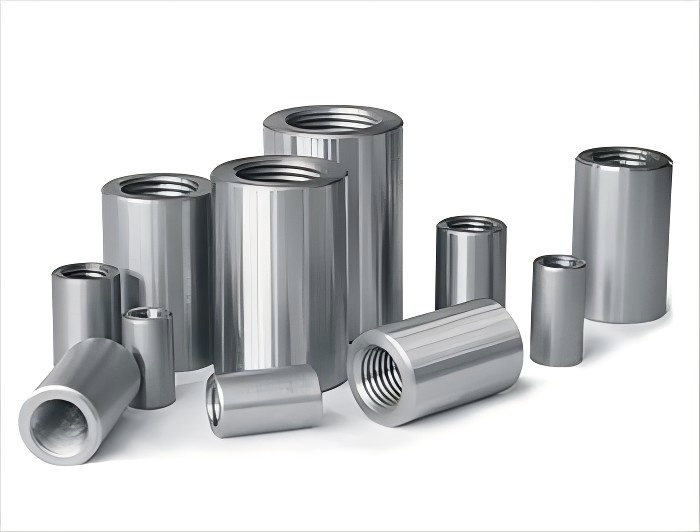Straight thread rebar couplers are widely used in construction projects to connect reinforcing steel bars (rebars) efficiently, ensuring structural stability and reducing on-site welding work. Unlike traditional splicing methods, they offer high tensile strength, easy operation, and compatibility with most rebar grades. Below is a step-by-step guide to using them correctly, along with key preparation tips and safety notes.
1. Pre-Use Preparation: Check Materials and Tools
Before starting, ensure all materials and tools meet construction standards to avoid connection failures.
- Materials to Verify:
- Straight thread rebar couplers: Confirm they match the rebar diameter (e.g., 16mm couplers for 16mm rebars) and bear certification marks (e.g., ISO or local construction standards) to ensure quality. Check for cracks, deformations, or rust on the coupler’s internal threads—discard defective ones.
- Rebars: Ensure rebars are free of dirt, oil, or rust at the ends (these can damage threads). The rebar grade (e.g., HRB400) should align with the coupler’s load-bearing capacity.
- Necessary Tools:Prepare a rebar thread rolling machine (to process rebar ends into straight threads), a thread gauge (to check thread accuracy), a torque wrench (to control connection tightness), and a wire brush (to clean rebar ends).
2. Step 1: Process Rebar Ends into Straight Threads
The quality of rebar threads directly affects the coupler’s performance—this step requires precision.
- Trim Rebar Ends: Use a cutting machine to cut rebar ends flat (avoid slanting cuts), ensuring the length of the processed thread meets design requirements (usually 10–15mm longer than the coupler’s half-length).
- Roll Threads with Machine: Secure the rebar in the thread rolling machine. Adjust the machine’s pressure and speed according to the rebar diameter (follow the machine manual). Start rolling until the threads are uniform, with no burrs or missing teeth.
- Inspect Threads: Use a thread gauge (go/no-go gauge) to test the threads. The “go” end should pass through the rebar threads smoothly, while the “no-go” end should stop at the first 2–3 threads—this confirms the thread size is correct.
3. Step 2: Connect Rebars with the Coupler
Follow this sequence to ensure a tight, stable connection between two rebars.
- Clean Threads: Use a wire brush to wipe off metal shavings, dust, or oil from the rebar threads and the coupler’s internal threads. Dirty threads can cause loose connections or thread damage.
- Screw Rebar into Coupler (First Side): Hold one rebar and screw its threaded end into the coupler by hand until it can no longer turn freely. Ensure the rebar is aligned with the coupler (no tilting) to avoid cross-threading.
- Connect the Second Rebar: Take the second rebar and screw its threaded end into the other side of the coupler by hand. Keep both rebars straight during this process—misalignment may reduce the connection’s strength.
- Tighten with Torque Wrench: Use a torque wrench to tighten the coupler. Refer to the coupler’s specifications for the required torque (e.g., 120 N·m for 20mm couplers). Stop when the wrench clicks, indicating the correct tightness—over-tightening may damage threads, while under-tightening causes looseness.
4. Post-Connection Inspection: Ensure Quality
After installation, inspect each connection to confirm it meets structural standards.
- Visual Check: Verify that both rebars are fully inserted into the coupler (no gaps between the rebar ends and the coupler’s inner wall). Check for thread deformation or coupler cracks—replace any faulty connections immediately.
- Torque Recheck: Randomly select 10% of the connections and re-test their tightness with a torque wrench. If more than 1 connection fails the torque test, inspect all connections in the batch.
- Documentation: Record details like the coupler batch number, rebar grade, and inspection results. This helps trace quality issues later.
5. Safety and Maintenance Tips
- Safety Precautions: Wear gloves and safety goggles when operating the thread rolling machine to prevent metal shavings from injuring hands or eyes. Keep the work area clean to avoid tripping hazards.
- Coupler Storage: Store unused couplers in a dry, ventilated area to prevent rust. Avoid stacking heavy objects on them, as this can deform internal threads.
- Tool Maintenance: Regularly oil the thread rolling machine and torque wrench to ensure smooth operation. Calibrate the torque wrench every 6 months to maintain accuracy.
In summary, using straight thread rebar couplers requires strict adherence to preparation, processing, connection, and inspection steps. By following this guide, you can ensure strong, reliable rebar connections that meet construction safety and durability requirements.

